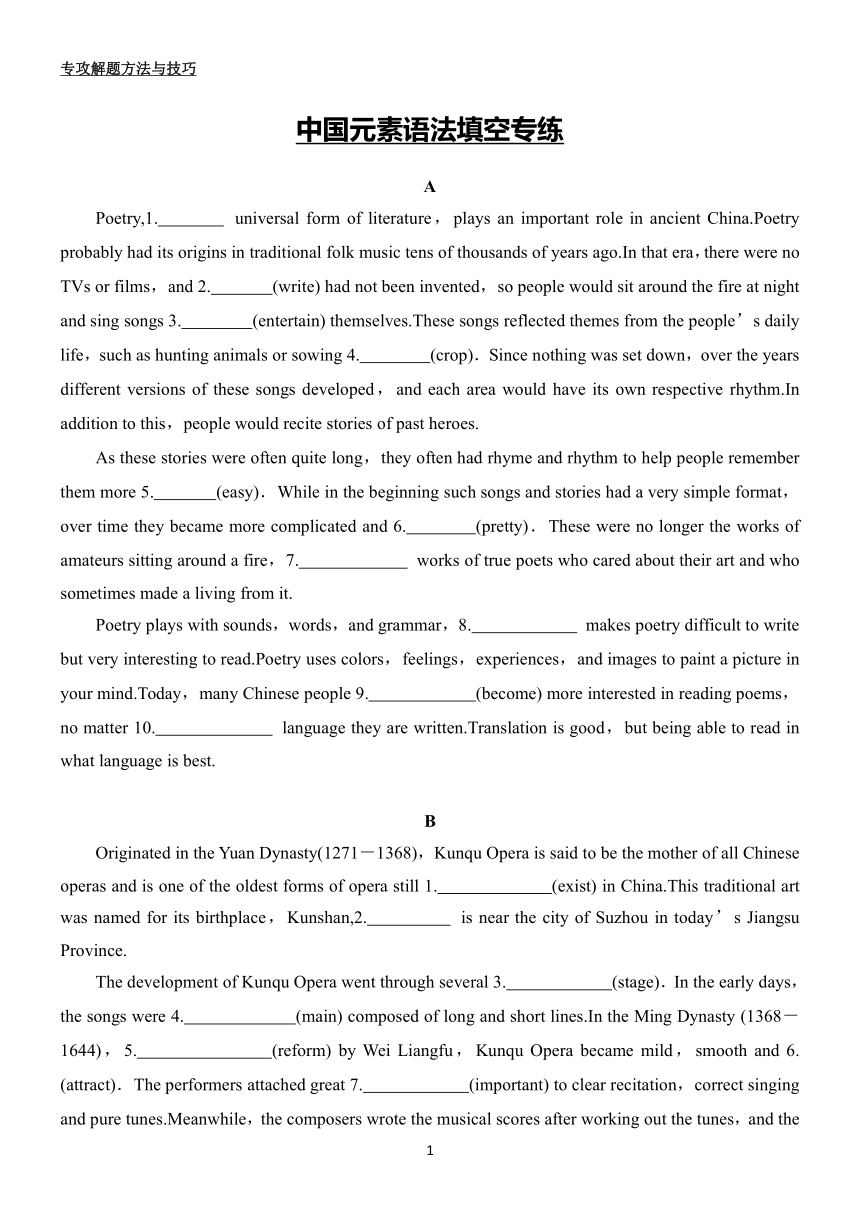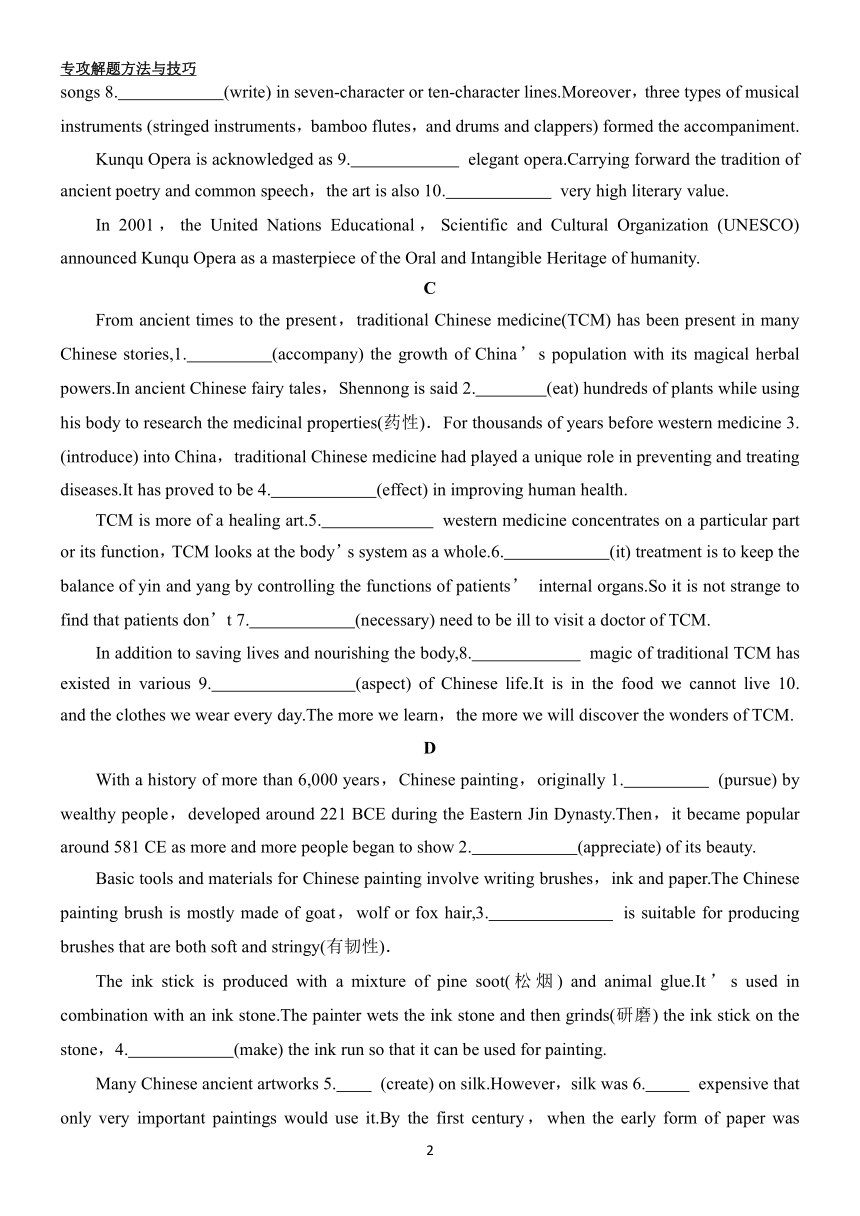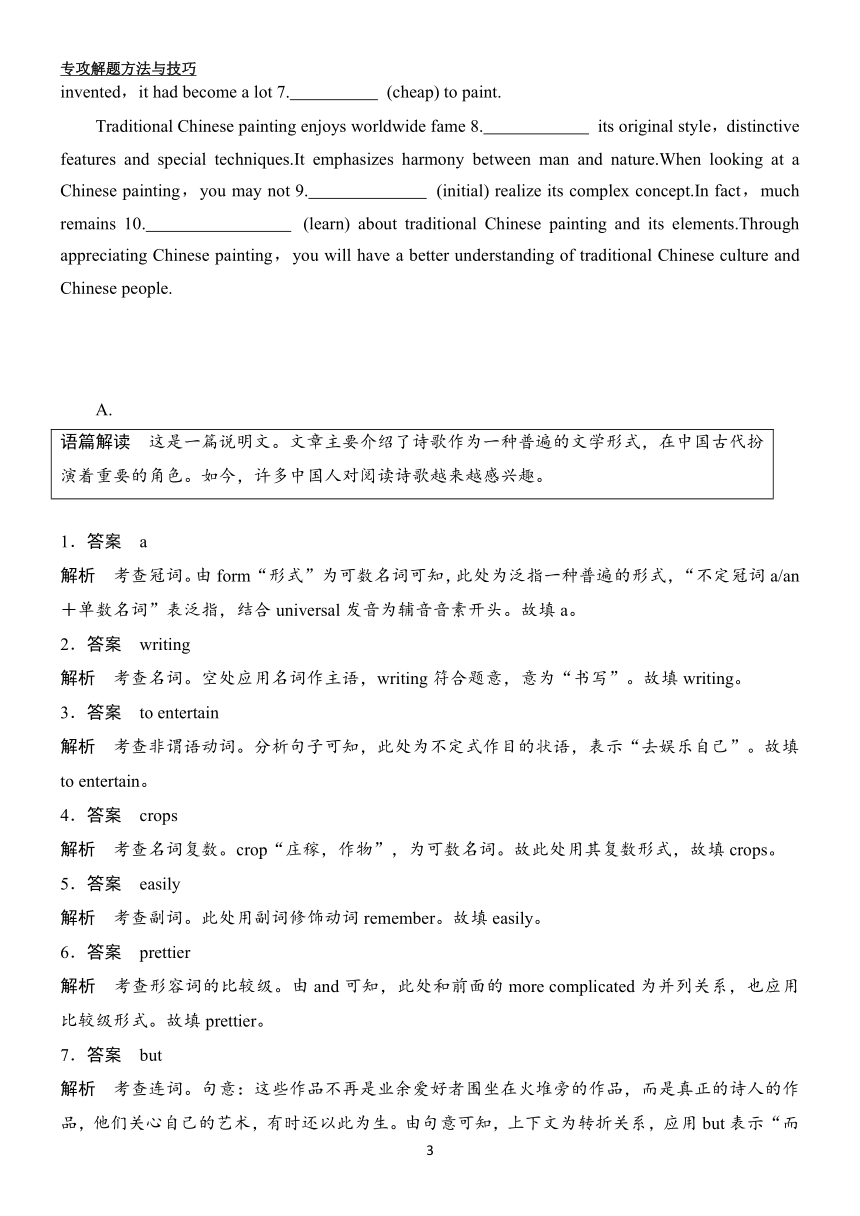高考英语二轮复习中国元素语法填空专练(含解析)
文档属性
| 名称 | 高考英语二轮复习中国元素语法填空专练(含解析) |  | |
| 格式 | zip | ||
| 文件大小 | 46.0KB | ||
| 资源类型 | 教案 | ||
| 版本资源 | 人教版(2019) | ||
| 科目 | 英语 | ||
| 更新时间 | 2023-04-01 11:27:50 | ||
图片预览



文档简介
专攻解题方法与技巧
中国元素语法填空专练
A
Poetry,1. universal form of literature,plays an important role in ancient China.Poetry probably had its origins in traditional folk music tens of thousands of years ago.In that era,there were no TVs or films,and 2. (write) had not been invented,so people would sit around the fire at night and sing songs 3. (entertain) themselves.These songs reflected themes from the people’s daily life,such as hunting animals or sowing 4. (crop).Since nothing was set down,over the years different versions of these songs developed,and each area would have its own respective rhythm.In addition to this,people would recite stories of past heroes.
As these stories were often quite long,they often had rhyme and rhythm to help people remember them more 5. (easy).While in the beginning such songs and stories had a very simple format,over time they became more complicated and 6. (pretty).These were no longer the works of amateurs sitting around a fire,7. works of true poets who cared about their art and who sometimes made a living from it.
Poetry plays with sounds,words,and grammar,8. makes poetry difficult to write but very interesting to read.Poetry uses colors,feelings,experiences,and images to paint a picture in your mind.Today,many Chinese people 9. (become) more interested in reading poems,no matter 10. language they are written.Translation is good,but being able to read in what language is best.
B
Originated in the Yuan Dynasty(1271-1368),Kunqu Opera is said to be the mother of all Chinese operas and is one of the oldest forms of opera still 1. (exist) in China.This traditional art was named for its birthplace,Kunshan,2. is near the city of Suzhou in today’s Jiangsu Province.
The development of Kunqu Opera went through several 3. (stage).In the early days,the songs were 4. (main) composed of long and short lines.In the Ming Dynasty (1368-1644),5. (reform) by Wei Liangfu,Kunqu Opera became mild,smooth and 6. (attract).The performers attached great 7. (important) to clear recitation,correct singing and pure tunes.Meanwhile,the composers wrote the musical scores after working out the tunes,and the songs 8. (write) in seven-character or ten-character lines.Moreover,three types of musical instruments (stringed instruments,bamboo flutes,and drums and clappers) formed the accompaniment.
Kunqu Opera is acknowledged as 9. elegant opera.Carrying forward the tradition of ancient poetry and common speech,the art is also 10. very high literary value.
In 2001,the United Nations Educational,Scientific and Cultural Organization (UNESCO) announced Kunqu Opera as a masterpiece of the Oral and Intangible Heritage of humanity.
C
From ancient times to the present,traditional Chinese medicine(TCM) has been present in many Chinese stories,1. (accompany) the growth of China’s population with its magical herbal powers.In ancient Chinese fairy tales,Shennong is said 2. (eat) hundreds of plants while using his body to research the medicinal properties(药性).For thousands of years before western medicine 3. (introduce) into China,traditional Chinese medicine had played a unique role in preventing and treating diseases.It has proved to be 4. (effect) in improving human health.
TCM is more of a healing art.5. western medicine concentrates on a particular part or its function,TCM looks at the body’s system as a whole.6. (it) treatment is to keep the balance of yin and yang by controlling the functions of patients’ internal organs.So it is not strange to find that patients don’t 7. (necessary) need to be ill to visit a doctor of TCM.
In addition to saving lives and nourishing the body,8. magic of traditional TCM has existed in various 9. (aspect) of Chinese life.It is in the food we cannot live 10. and the clothes we wear every day.The more we learn,the more we will discover the wonders of TCM.
D
With a history of more than 6,000 years,Chinese painting,originally 1. (pursue) by wealthy people,developed around 221 BCE during the Eastern Jin Dynasty.Then,it became popular around 581 CE as more and more people began to show 2. (appreciate) of its beauty.
Basic tools and materials for Chinese painting involve writing brushes,ink and paper.The Chinese painting brush is mostly made of goat,wolf or fox hair,3. is suitable for producing brushes that are both soft and stringy(有韧性).
The ink stick is produced with a mixture of pine soot(松烟) and animal glue.It’s used in combination with an ink stone.The painter wets the ink stone and then grinds(研磨) the ink stick on the stone,4. (make) the ink run so that it can be used for painting.
Many Chinese ancient artworks 5. (create) on silk.However,silk was 6. expensive that only very important paintings would use it.By the first century,when the early form of paper was invented,it had become a lot 7. (cheap) to paint.
Traditional Chinese painting enjoys worldwide fame 8. its original style,distinctive features and special techniques.It emphasizes harmony between man and nature.When looking at a Chinese painting,you may not 9. (initial) realize its complex concept.In fact,much remains 10. (learn) about traditional Chinese painting and its elements.Through appreciating Chinese painting,you will have a better understanding of traditional Chinese culture and Chinese people.
语篇解读 这是一篇说明文。文章主要介绍了诗歌作为一种普遍的文学形式,在中国古代扮演着重要的角色。如今,许多中国人对阅读诗歌越来越感兴趣。
1.答案 a
解析 考查冠词。由form“形式”为可数名词可知,此处为泛指一种普遍的形式,“不定冠词a/an+单数名词”表泛指,结合universal发音为辅音音素开头。故填a。
2.答案 writing
解析 考查名词。空处应用名词作主语,writing符合题意,意为“书写”。故填writing。
3.答案 to entertain
解析 考查非谓语动词。分析句子可知,此处为不定式作目的状语,表示“去娱乐自己”。故填to entertain。
4.答案 crops
解析 考查名词复数。crop“庄稼,作物”,为可数名词。故此处用其复数形式,故填crops。
5.答案 easily
解析 考查副词。此处用副词修饰动词remember。故填easily。
6.答案 prettier
解析 考查形容词的比较级。由and可知,此处和前面的more complicated为并列关系,也应用比较级形式。故填prettier。
7.答案 but
解析 考查连词。句意:这些作品不再是业余爱好者围坐在火堆旁的作品,而是真正的诗人的作品,他们关心自己的艺术,有时还以此为生。由句意可知,上下文为转折关系,应用but表示“而是”。故填but。
8.答案 which
解析 考查定语从句。分析句子可知,空处引导非限制性定语从句,先行词为Poetry plays with sounds,words,and grammar,在从句中作主语,应用关系代词which引导。故填which。
9.答案 are becoming
解析 考查动词时态和主谓一致。由前面的时间状语“Today”和句意可知,该句用现在进行时,表示目前正在持续的动作,结合主语many Chinese people为复数形式,故填are becoming。
10.答案 what
解析 考查状语从句。此处为no matter what引导让步状语从句,表示“无论它们是用什么语言写的”。故填what。
B.
1.答案 existing
解析 考查非谓语动词。分析句子结构可知,句中已有谓语动词is,空处需填非谓语动词作后置定语,修饰opera,二者是逻辑上的主谓关系,需用现在分词形式。故填existing。
2.答案 which
解析 考查定语从句。空处引导非限制性定语从句,先行词Kunshan指物,在定语从句中作主语,需用关系代词which引导。故填which。
3.答案 stages
解析 考查名词复数。stage意为“阶段”,是可数名词,several后面需加可数名词复数形式。故填stages。
4.答案 mainly
解析 考查副词。修饰动词短语were composed of,需用副词作状语。故填mainly。
5.答案 reformed
解析 考查非谓语动词。分析句子结构可知,句中已有谓语动词became,空处需填非谓语动词作状语,Kunqu Opera和reform为逻辑上的动宾关系,需用过去分词形式。故填reformed。
6.答案 attractive
解析 考查形容词。became为系动词,后面需加形容词作表语。故填attractive。
7.答案 importance
解析 考查名词。attach great importance to为固定短语,意为“非常重视……”。故填importance。
8.答案 were written
解析 考查动词时态、语态和主谓一致。根据wrote可知,此处使用一般过去时;主语the songs和write为被动关系,需用被动语态;主语为复数名词,be动词用were。故填were written。
9.答案 an
解析 考查冠词。opera为可数名词,此处表示泛指,且elegant发音以元音音素开头,需用不定冠词an修饰。故填an。
10.答案 of
解析 考查介词。be of value为固定用法,意为“有价值”。故填of。
C.
1.答案 accompanying
解析 考查非谓语动词。分析句子结构可知,accompany在句中应用非谓语动词形式,与其逻辑主语traditional Chinese medicine构成主动关系,故用现在分词作状语。故填accompanying。
2.答案 to eat
解析 考查非谓语动词。此处为固定短语be said to do sth.表示“据说……”。故填to eat。
3.答案 was introduced
解析 考查动词时态、语态和主谓一致。从句主语与introduce构成被动关系,且描述过去发生的事情,用一般过去时的被动语态;主语为单数,谓语也应用单数。故填was introduced。
4.答案 effective
解析 考查形容词。此处为形容词作表语,表示“有效的”。故填effective。
5.答案 Although/Though/While
解析 考查状语从句。根据语境及句子结构可知,此处引导让步状语从句,表示“虽然”应用although,though或while,句首单词首字母要大写。故填Although/Though/While。
6.答案 Its
解析 考查代词。修饰空后名词treatment应用形容词性物主代词,句首单词首字母要大写。故填Its。
7.答案 necessarily
解析 考查副词。修饰动词need应用副词necessarily,作状语。故填necessarily。
8.答案 the
解析 考查冠词。此处特指传统中医的魔力,应用定冠词。故填the。
9.答案 aspects
解析 考查名词复数。aspect为可数名词,由various修饰应用复数形式。故填aspects。
10.答案 without
解析 考查介词。结合句意表示“赖以生存”,应用短语cannot live without。故填without。
D.
语篇解读 本文是一篇说明文。文章介绍了中国画的发展历史,以及它享有的国际声誉,通过欣赏中国画,你将会更好地了解中国传统文化和中国人。
1.答案 pursued
解析 考查过去分词。分析句子可知,空处作定语,修饰Chinese painting,pursue与Chinese painting是动宾关系,用过去分词形式,故填pursued。
2.答案 appreciation
解析 考查名词。分析句子可知,动词后接名词作宾语,appreciation“感激”,是不可数名词。故填appreciation。
3.答案 which
解析 考查定语从句。分析句子可知,空格处引导定语从句,指代整个主句,在从句中作主语。故填which。
4.答案 making
解析 考查非谓语动词。分析句子可知,句子的谓语动词是wets和grinds,故make用非谓语动词形式作状语,make与其逻辑主语是主动关系,故用现在分词形式。故填making。
5.答案 were created
解析 考查动词时态、语态和主谓一致。分析句子可知,create是谓语动词,与主语artworks是被动关系,用被动语态;描述过去发生的事情用一般过去时,且主语artworks是复数,谓语动词用复数,故填were created。
6.答案 so
解析 考查状语从句。根据句意以及下文的that可知,此处用so...that...引导状语从句。故填so。
7.答案 cheaper
解析 考查形容词比较级。根据句意以及空前的a lot可知,此处用形容词cheap的比较级作表语。故填cheaper。
8.答案 for
解析 考查介词。根据句意,表示原因用介词for。
9.答案 initially
解析 考查副词。修饰动词用副词作状语,故填initially。
10.答案 to be learned/learnt
解析 考查非谓语动词。分析句子可知,remain是系动词,接不定式作表语,主语much与谓语动词learn是被动关系,故用不定式的被动式。故填to be learned/learnt。
中国元素语法填空专练
A
Poetry,1. universal form of literature,plays an important role in ancient China.Poetry probably had its origins in traditional folk music tens of thousands of years ago.In that era,there were no TVs or films,and 2. (write) had not been invented,so people would sit around the fire at night and sing songs 3. (entertain) themselves.These songs reflected themes from the people’s daily life,such as hunting animals or sowing 4. (crop).Since nothing was set down,over the years different versions of these songs developed,and each area would have its own respective rhythm.In addition to this,people would recite stories of past heroes.
As these stories were often quite long,they often had rhyme and rhythm to help people remember them more 5. (easy).While in the beginning such songs and stories had a very simple format,over time they became more complicated and 6. (pretty).These were no longer the works of amateurs sitting around a fire,7. works of true poets who cared about their art and who sometimes made a living from it.
Poetry plays with sounds,words,and grammar,8. makes poetry difficult to write but very interesting to read.Poetry uses colors,feelings,experiences,and images to paint a picture in your mind.Today,many Chinese people 9. (become) more interested in reading poems,no matter 10. language they are written.Translation is good,but being able to read in what language is best.
B
Originated in the Yuan Dynasty(1271-1368),Kunqu Opera is said to be the mother of all Chinese operas and is one of the oldest forms of opera still 1. (exist) in China.This traditional art was named for its birthplace,Kunshan,2. is near the city of Suzhou in today’s Jiangsu Province.
The development of Kunqu Opera went through several 3. (stage).In the early days,the songs were 4. (main) composed of long and short lines.In the Ming Dynasty (1368-1644),5. (reform) by Wei Liangfu,Kunqu Opera became mild,smooth and 6. (attract).The performers attached great 7. (important) to clear recitation,correct singing and pure tunes.Meanwhile,the composers wrote the musical scores after working out the tunes,and the songs 8. (write) in seven-character or ten-character lines.Moreover,three types of musical instruments (stringed instruments,bamboo flutes,and drums and clappers) formed the accompaniment.
Kunqu Opera is acknowledged as 9. elegant opera.Carrying forward the tradition of ancient poetry and common speech,the art is also 10. very high literary value.
In 2001,the United Nations Educational,Scientific and Cultural Organization (UNESCO) announced Kunqu Opera as a masterpiece of the Oral and Intangible Heritage of humanity.
C
From ancient times to the present,traditional Chinese medicine(TCM) has been present in many Chinese stories,1. (accompany) the growth of China’s population with its magical herbal powers.In ancient Chinese fairy tales,Shennong is said 2. (eat) hundreds of plants while using his body to research the medicinal properties(药性).For thousands of years before western medicine 3. (introduce) into China,traditional Chinese medicine had played a unique role in preventing and treating diseases.It has proved to be 4. (effect) in improving human health.
TCM is more of a healing art.5. western medicine concentrates on a particular part or its function,TCM looks at the body’s system as a whole.6. (it) treatment is to keep the balance of yin and yang by controlling the functions of patients’ internal organs.So it is not strange to find that patients don’t 7. (necessary) need to be ill to visit a doctor of TCM.
In addition to saving lives and nourishing the body,8. magic of traditional TCM has existed in various 9. (aspect) of Chinese life.It is in the food we cannot live 10. and the clothes we wear every day.The more we learn,the more we will discover the wonders of TCM.
D
With a history of more than 6,000 years,Chinese painting,originally 1. (pursue) by wealthy people,developed around 221 BCE during the Eastern Jin Dynasty.Then,it became popular around 581 CE as more and more people began to show 2. (appreciate) of its beauty.
Basic tools and materials for Chinese painting involve writing brushes,ink and paper.The Chinese painting brush is mostly made of goat,wolf or fox hair,3. is suitable for producing brushes that are both soft and stringy(有韧性).
The ink stick is produced with a mixture of pine soot(松烟) and animal glue.It’s used in combination with an ink stone.The painter wets the ink stone and then grinds(研磨) the ink stick on the stone,4. (make) the ink run so that it can be used for painting.
Many Chinese ancient artworks 5. (create) on silk.However,silk was 6. expensive that only very important paintings would use it.By the first century,when the early form of paper was invented,it had become a lot 7. (cheap) to paint.
Traditional Chinese painting enjoys worldwide fame 8. its original style,distinctive features and special techniques.It emphasizes harmony between man and nature.When looking at a Chinese painting,you may not 9. (initial) realize its complex concept.In fact,much remains 10. (learn) about traditional Chinese painting and its elements.Through appreciating Chinese painting,you will have a better understanding of traditional Chinese culture and Chinese people.
语篇解读 这是一篇说明文。文章主要介绍了诗歌作为一种普遍的文学形式,在中国古代扮演着重要的角色。如今,许多中国人对阅读诗歌越来越感兴趣。
1.答案 a
解析 考查冠词。由form“形式”为可数名词可知,此处为泛指一种普遍的形式,“不定冠词a/an+单数名词”表泛指,结合universal发音为辅音音素开头。故填a。
2.答案 writing
解析 考查名词。空处应用名词作主语,writing符合题意,意为“书写”。故填writing。
3.答案 to entertain
解析 考查非谓语动词。分析句子可知,此处为不定式作目的状语,表示“去娱乐自己”。故填to entertain。
4.答案 crops
解析 考查名词复数。crop“庄稼,作物”,为可数名词。故此处用其复数形式,故填crops。
5.答案 easily
解析 考查副词。此处用副词修饰动词remember。故填easily。
6.答案 prettier
解析 考查形容词的比较级。由and可知,此处和前面的more complicated为并列关系,也应用比较级形式。故填prettier。
7.答案 but
解析 考查连词。句意:这些作品不再是业余爱好者围坐在火堆旁的作品,而是真正的诗人的作品,他们关心自己的艺术,有时还以此为生。由句意可知,上下文为转折关系,应用but表示“而是”。故填but。
8.答案 which
解析 考查定语从句。分析句子可知,空处引导非限制性定语从句,先行词为Poetry plays with sounds,words,and grammar,在从句中作主语,应用关系代词which引导。故填which。
9.答案 are becoming
解析 考查动词时态和主谓一致。由前面的时间状语“Today”和句意可知,该句用现在进行时,表示目前正在持续的动作,结合主语many Chinese people为复数形式,故填are becoming。
10.答案 what
解析 考查状语从句。此处为no matter what引导让步状语从句,表示“无论它们是用什么语言写的”。故填what。
B.
1.答案 existing
解析 考查非谓语动词。分析句子结构可知,句中已有谓语动词is,空处需填非谓语动词作后置定语,修饰opera,二者是逻辑上的主谓关系,需用现在分词形式。故填existing。
2.答案 which
解析 考查定语从句。空处引导非限制性定语从句,先行词Kunshan指物,在定语从句中作主语,需用关系代词which引导。故填which。
3.答案 stages
解析 考查名词复数。stage意为“阶段”,是可数名词,several后面需加可数名词复数形式。故填stages。
4.答案 mainly
解析 考查副词。修饰动词短语were composed of,需用副词作状语。故填mainly。
5.答案 reformed
解析 考查非谓语动词。分析句子结构可知,句中已有谓语动词became,空处需填非谓语动词作状语,Kunqu Opera和reform为逻辑上的动宾关系,需用过去分词形式。故填reformed。
6.答案 attractive
解析 考查形容词。became为系动词,后面需加形容词作表语。故填attractive。
7.答案 importance
解析 考查名词。attach great importance to为固定短语,意为“非常重视……”。故填importance。
8.答案 were written
解析 考查动词时态、语态和主谓一致。根据wrote可知,此处使用一般过去时;主语the songs和write为被动关系,需用被动语态;主语为复数名词,be动词用were。故填were written。
9.答案 an
解析 考查冠词。opera为可数名词,此处表示泛指,且elegant发音以元音音素开头,需用不定冠词an修饰。故填an。
10.答案 of
解析 考查介词。be of value为固定用法,意为“有价值”。故填of。
C.
1.答案 accompanying
解析 考查非谓语动词。分析句子结构可知,accompany在句中应用非谓语动词形式,与其逻辑主语traditional Chinese medicine构成主动关系,故用现在分词作状语。故填accompanying。
2.答案 to eat
解析 考查非谓语动词。此处为固定短语be said to do sth.表示“据说……”。故填to eat。
3.答案 was introduced
解析 考查动词时态、语态和主谓一致。从句主语与introduce构成被动关系,且描述过去发生的事情,用一般过去时的被动语态;主语为单数,谓语也应用单数。故填was introduced。
4.答案 effective
解析 考查形容词。此处为形容词作表语,表示“有效的”。故填effective。
5.答案 Although/Though/While
解析 考查状语从句。根据语境及句子结构可知,此处引导让步状语从句,表示“虽然”应用although,though或while,句首单词首字母要大写。故填Although/Though/While。
6.答案 Its
解析 考查代词。修饰空后名词treatment应用形容词性物主代词,句首单词首字母要大写。故填Its。
7.答案 necessarily
解析 考查副词。修饰动词need应用副词necessarily,作状语。故填necessarily。
8.答案 the
解析 考查冠词。此处特指传统中医的魔力,应用定冠词。故填the。
9.答案 aspects
解析 考查名词复数。aspect为可数名词,由various修饰应用复数形式。故填aspects。
10.答案 without
解析 考查介词。结合句意表示“赖以生存”,应用短语cannot live without。故填without。
D.
语篇解读 本文是一篇说明文。文章介绍了中国画的发展历史,以及它享有的国际声誉,通过欣赏中国画,你将会更好地了解中国传统文化和中国人。
1.答案 pursued
解析 考查过去分词。分析句子可知,空处作定语,修饰Chinese painting,pursue与Chinese painting是动宾关系,用过去分词形式,故填pursued。
2.答案 appreciation
解析 考查名词。分析句子可知,动词后接名词作宾语,appreciation“感激”,是不可数名词。故填appreciation。
3.答案 which
解析 考查定语从句。分析句子可知,空格处引导定语从句,指代整个主句,在从句中作主语。故填which。
4.答案 making
解析 考查非谓语动词。分析句子可知,句子的谓语动词是wets和grinds,故make用非谓语动词形式作状语,make与其逻辑主语是主动关系,故用现在分词形式。故填making。
5.答案 were created
解析 考查动词时态、语态和主谓一致。分析句子可知,create是谓语动词,与主语artworks是被动关系,用被动语态;描述过去发生的事情用一般过去时,且主语artworks是复数,谓语动词用复数,故填were created。
6.答案 so
解析 考查状语从句。根据句意以及下文的that可知,此处用so...that...引导状语从句。故填so。
7.答案 cheaper
解析 考查形容词比较级。根据句意以及空前的a lot可知,此处用形容词cheap的比较级作表语。故填cheaper。
8.答案 for
解析 考查介词。根据句意,表示原因用介词for。
9.答案 initially
解析 考查副词。修饰动词用副词作状语,故填initially。
10.答案 to be learned/learnt
解析 考查非谓语动词。分析句子可知,remain是系动词,接不定式作表语,主语much与谓语动词learn是被动关系,故用不定式的被动式。故填to be learned/learnt。
